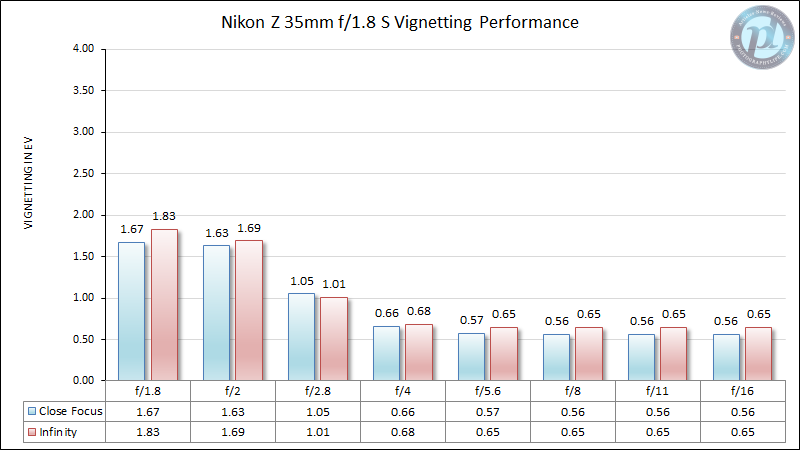Focusing Characteristics
All Nikon Z-series lenses, including the Z 35mm f/1.8 S, use a “focus-by-wire” stepping motor when autofocusing, which means that focusing is fully electronic. While some photographers prefer the tactile feel of a mechanically-coupled lens instead, there is no denying that the Nikon Z 35mm f/1.8 S focuses quickly, quietly, and accurately, even in low-light conditions.

The close-focusing capabilities of the Nikon Z 35mm f/1.8 S are perfectly acceptable but nothing extraordinary. The lens’s minimum focusing distance of 25 cm / 10 inches results in a maximum magnification of 0.19× (also written as 1:5.3 magnification). This is enough to fill your composition with a subject that is approximately 19 cm / 7.5 inches wide, assuming the use of a full-frame camera. It’s enough for decent close-ups and “intimate landscapes,” but hardly a true macro lens.

Distortion
Lens distortion is not particularly pronounced on the Nikon Z 35mm f/1.8 S. Imatest measures -1.21% barrel distortion, which is not something you would notice in most of your images. If you use Lightroom, it will automatically apply distortion correction anyway, so that you don’t have to worry about fixing it. If you shoot a lot of straight lines and you use post-processing software other than Lightroom and Photoshop, then you might need to take care of it manually, but it’s still not a concern at this level.
Here’s a simulation of -1.21% barrel distortion:

Vignetting
The Nikon Z 35mm f/1.8 S exhibits a modest level of vignetting, as can be seen from the below chart:

We can see that vignetting characteristics are a little worse at infinity focus overall, but never bad. Stopping down to f/2.8 is enough to get negligible vignetting around 1 stop of darkening in the corners. Here is an illustration of how the light falls off in the worst-case scenario of vignetting at f/1.8 and infinity focus:

Using filters with the lens is not a problem – you will not see any additional vignetting issues as a result of filter use, unless you are stacking multiple thick filters.
Lateral Chromatic Aberration
Chromatic aberration is controlled extremely well on the Nikon Z 35mm f/1.8 S, as can be seen from the chart below:

As you can see, Imatest measured hardly any lateral chromatic aberration at wide apertures. There is a bit more when stopped down beyond f/4, but still totally negligible. Anything under 1 pixel of CA in our tests is unlikely to need corrections even when photographing high-contrast subjects.

Sharpness
The Nikon Z 35mm f/1.8 S is a sharp lens, especially after stopping down to f/2.8 through f/8. (As with all lenses, diffraction takes a toll at narrower apertures like f/11 and f/16, which is not the fault of this particular lens.) Here is how Imatest measured the sharpness performance at different apertures:

As you can see, the Nikon Z 35mm f/1.8 S starts out a bit weaker at maximum aperture and f/2, but once stopped down to f/2.8, it yields very high sharpness numbers in the center. The corners and midframes continue to improve as you stop down, with f/5.6 offering the best results in those areas of the frame. Apart from the slightly weaker performance at f/1.8 and f/2, there is nothing to criticize here at all, and a lot to like!
Similar to most other lenses on the market, the Nikon Z 35mm f/1.8 S does have some mild field curvature, although it is not highly pronounced. You can minimize the problem by stopping down a little. In our testing, we found little to no focus shift (change in focus when adjusting aperture) with the Nikon Z 35mm f/1.8 S.
Finally, Nikon has done a remarkable job with sample variation. We tested three couple of copies of the Z 35mm f/1.8 S lenses for this review and found them to be equally sharp with no decentering issues.
Early Access:
See all of our sharpness tests weeks (or months) before we publish the full review when you become a Photography Life Member. Photography Life Members can also access our Online Workshops, monthly photo critiques, Creative Landscape Photography eBook, and more. Get more information here or join today!
Focus Breathing
Just like Nikon promises in its marketing materials, the Z 35mm f/1.8 S has focus breathing compensation built in, so you do not have to worry about your composition changing drastically when you focus the lens. This essentially makes the lens very useful for video recording and focus stacking purposes.

Bokeh
While the Nikon Z 35mm f/1.8 S is a bit too wide for tight portrait photos, it has a fast f/1.8 aperture that makes it a potentially good candidate to separate subjects from the scene, especially if they are close to the camera. I have taken a number of shots at large apertures with this lens, and I was surprised to see that its bokeh performance is quite good for a 35mm lens. Take a look at the following sample image. I think you’ll be impressed by the out-of-focus areas of the frame.

There is a little bit of edge definition in brighter areas of the scene, but it is not too distracting. Here is another image that shows background highlights at night in a highly demanding scene:

Here, we can see some modest “cat’s eye” bokeh in the corners of the frame, as well as signs of aspherical lens elements – mild onion-textured rings in the highlights. This texture is not unique to the Nikon Z 35mm f/1.8 S and is found in almost every other 35mm lens with aspherical elements, but I feel the need to point it out regardless.
As always, bokeh is in the eye of the beholder, so my recommendation would be to look at the image samples presented in this review and make your own conclusions.
Flare and Sunstars
For landscape photography, one of the most important overlooked factors in lens performance is flare. In backlit situations, some lenses have excessive internal reflections that appear in the photo as ugly blobs. Other lenses will drastically lose contrast in what is known as “veiling flare.” Based on our field experience, the Nikon Z 35mm f/1.8 S shows very little ghosting and flare with the sun in the frame, as can be seen below:

The angle of light and the position of the sun in the frame can certainly impact the way lenses handle ghosting and flare, but in the case of the Z 35mm f/1.8 S, we haven’t seen any instances where flare performance has seriously hurt images. Nikon did an excellent job with lens coatings, and it really shows here.
Similar to other 9-blade rounded aperture lenses, the Nikon Z 35mm f/1.8 S produces 18-point starbursts / sunstars in images when a source of light is bright and small. You can see from the above photo how the lens does when stopped down to f/13, which to me looks pretty decent – a little on the weak side, but not very different from what one would normally see from 9-blade diaphragm lenses.
The next page of this review dives into the sharpness numbers a bit more, with some comparisons against other lenses that Nikon users may be considering. So, click the menu below to go to “Lens Comparisons”:
Table of Contents